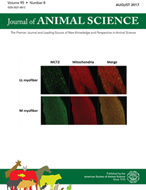Ver ítem
- xmlui.general.dspace_homeCentros Regionales y EEAsCentro Regional La Pampa - San LuisEEA AnguilArtículos científicosxmlui.ArtifactBrowser.ItemViewer.trail
- Inicio
- Centros Regionales y EEAs
- Centro Regional La Pampa - San Luis
- EEA Anguil
- Artículos científicos
- Ver ítem
Supplementation of glycerol or fructose via drinking water to grazing lambs on tissue glycogen level and lipogenesis
Resumen
Lambs (n = 18; 40.1 ± 7.4 kg BW) were used to assess supplementation of glycerol or fructose via drinking water on growth, tissue glycogen levels, postmortem glycolysis, and lipogenesis. Lambs were blocked by BW and allocated to alfalfa paddocks (2 lambs/paddock and 3 paddocks/treatment). Each paddock within a block was assigned randomly to drinking water treatments for 30 d: 1) control (CON), 2) 120 g fructose/L of drinking water (FRU), or 3) 120 g
[ver mas...]
Lambs (n = 18; 40.1 ± 7.4 kg BW) were used to assess supplementation of glycerol or fructose via drinking water on growth, tissue glycogen levels, postmortem glycolysis, and lipogenesis. Lambs were blocked by BW and allocated to alfalfa paddocks (2 lambs/paddock and 3 paddocks/treatment). Each paddock within a block was assigned randomly to drinking water treatments for 30 d: 1) control (CON), 2) 120 g fructose/L of drinking water (FRU), or 3) 120 g glycerol/L of drinking water (GLY). Lambs grazed alfalfa with free access to water treatments for 28 d and then were fasted in indoor pens for a final 2 d with access to only water treatments. Data were analyzed using the MIXED procedure of SAS with water treatment and time (when appropriate) in the model. During the 28-d grazing period, ADG was greater (P < 0.05) for GLY than for CON or FRU. During the 2-d fasting period, BW shrink was lower (P < 0.05) for GLY compared with CON or FRU. Hot carcass weight was greater (P < 0.05) for GLY than for FRU. The interaction for glycogen content × postmortem time was significant (P = 0.003) in LM and semitendinosus (ST) muscles. Glycogen content in the LM was greater (P <0.05) for GLY at 2 and 3 h and for FRU at 1 h postmortem compared with CON. Glycogen content in ST did not differ between treatments (P > 0.05). Liver glycogen content was over 14-fold greater (P < 0.05) for GLY compared with FRU or CON. Liver free glucose was greater (P < 0.05) for GLY than for CON, whereas liver lipid content was higher (P < 0.05) for CON than for GLY. Supplementation with GLY increased (P <0.05) odd-chain fatty acids in LM, subcutaneous fat (SQ), and the liver. Stearic acid (C18:0) concentrations were reduced in LM (P = 0.064) and subcutaneous adipose tissue (SQ; P = 0.018), whereas oleic acid (C18:1 cis-9) concentration tended to be increased (P = 0.066) in SQ with FRU and GLY. Linolenic acid (C18:3n-3) was reduced (P = 0.031) and all long-chain n-3 fatty acid (eicosapentaenoic acid, docosapentaenoic acid, and docosahexaenoic acid) concentrations were increased (P < 0.05) with FRU and GLY compared with CON. Glycerol supplementation upregulated (P < 0.05) stearoyl-CoA desaturate (SCD1) and fatty acid synthase (FASN) mRNA by over 40-fold in the SQ and 5-fold in the liver. Glycerol supplementation also upregulated (P < 0.05) glucose transporters and glycogen branching enzyme in the liver. Overall, glycerol supplementation improved growth, reduced BW shrink during fasting, increased glycogen content in muscle and the liver, and stimulated de novo lipogenesis.
[Cerrar]

Autor
Volpi Lagreca, Gabriela;
Duckett, Susan K.;
Fuente
Journal of animal scence 95 (6) : 2558–2575. (2017)
Fecha
2017
ISSN
0021-8812
Formato
pdf
Tipo de documento
artículo
Palabras Claves
Derechos de acceso
Restringido
 Excepto donde se diga explicitamente, este item se publica bajo la siguiente descripción: Creative Commons Attribution-NonCommercial-ShareAlike 2.5 Unported (CC BY-NC-SA 2.5)
Excepto donde se diga explicitamente, este item se publica bajo la siguiente descripción: Creative Commons Attribution-NonCommercial-ShareAlike 2.5 Unported (CC BY-NC-SA 2.5)

